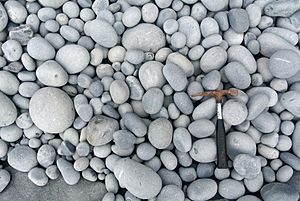Particle size (grain size) facts for kids
Have you ever wondered why some sand feels fine and soft, while other sand is rough and gritty? Or why some rocks are tiny pebbles and others are huge boulders? It all comes down to something called particle size, also known as grain size. This term describes how big individual pieces of material are. It's super important for understanding things like how beaches are formed, what kind of soil plants grow in, and even how different rocks are made.
Particle size helps scientists classify sediments. Sediments are tiny bits of rock, minerals, or organic matter that have been broken down by weather and erosion. When these sediments get pressed together over a long time, they can form new rocks!
How Do We Measure Particle Size?
Scientists use special ways to measure and describe particle sizes. One common way is using a chart called the Wentworth Scale. This scale helps everyone agree on what to call different sizes of particles, from the tiniest clay to the biggest boulders.
The Wentworth Scale: A Closer Look
The Wentworth Scale organizes particles into different groups based on their diameter (how wide they are). This makes it easy to talk about and compare different types of grains. Here's a simplified look at some of the main groups:
| Name of Particle | Size Range (Metric) | Size Range (Approx. Inches) | What it's like |
|---|---|---|---|
| Boulders | More than 256 mm | More than 10.1 in | These are very large rocks, bigger than a basketball! You often see them in rivers or at the bottom of cliffs. |
| Cobbles | 64–256 mm | 2.5–10.1 in | Cobbles are smaller than boulders but still quite big. Think of rocks about the size of a grapefruit or a football. |
| Pebbles | 4–64 mm | 0.157–2.5 in | Pebbles are small, smooth stones you often find on beaches or riverbeds. They can be as small as a pea or as big as a golf ball. |
| Granules | 2–4 mm | 0.079–0.157 in | These are tiny bits of rock, just barely bigger than a grain of sand. They feel a bit gritty. |
| Sand | 0.0625–2 mm | 0.0025–0.079 in | Sand is made of small, loose grains. It can be coarse (rough) or very fine (smooth), depending on the size of the individual grains. |
| Silt | 0.0039–0.0625 mm | 0.00015–0.0025 in | Silt particles are much smaller than sand. They feel smooth and powdery when dry, but slippery when wet. You might find silt in river mud. |
| Clay | Less than 0.0039 mm | Less than 0.00015 in | Clay particles are the smallest of all! They are so tiny you can't see individual grains without a microscope. Clay feels sticky when wet and hard when dry. |
Why is it Important to Know Particle Size?
Knowing the particle size of sediments and rocks helps us understand many things about our planet.
- Beaches: The size of sand grains affects how a beach feels and how easily it erodes. Fine sand beaches are soft, while coarse sand beaches can be rougher.
- Soil: Farmers care a lot about particle size in soil. Clay soils hold a lot of water, while sandy soils drain quickly. Silt soils are often very fertile.
- Water Flow: Water flows much faster through coarse sediments like gravel than through fine sediments like clay. This is important for understanding groundwater and how rivers move.
- Construction: Engineers use specific sizes of gravel and sand to make concrete or to build roads and foundations.
So, the next time you pick up a handful of sand or walk along a rocky beach, remember that the size of those tiny particles tells a big story about how our Earth works!



